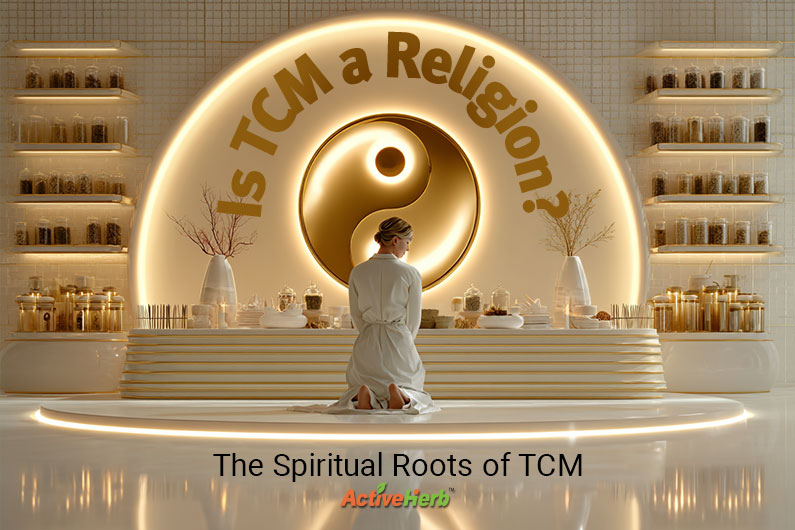Is TCM a Religion? The Spiritual Roots of TCM

Is Traditional Chinese Medicine a religion, or simply an ancient healing system? Or something in between?
TCM has deep roots in Daoist (Taoist) philosophy. Originating in China during the 4th or 5th century BCE, Daoism is often credited (albeit controversially) to Laozi (or Lao Tzu), the legendary author of the Dao De Jing (aka, the “Tao Te Ching”). The core tenet of Daoism is living in harmony with the Dao. “Dao” or “Daoist” is loosely translated as “The Way” or the underlying natural order of the universe.
Philosophical Examples of Living in Harmony with the Dao
Living with the Dao means recognizing that life flows best when we don’t fight against its currents. Daoist philosophy often stresses wu wei (“non-forcing”), a way of moving through life with ease rather than struggle. For instance:
- Yielding instead of resisting: Like a tree that bends in the wind rather than snapping, a person living in harmony with the Dao may let go of unnecessary arguments, choosing flexibility over pride.
- Appreciating simplicity: Daoism teaches that contentment comes from valuing what is natural and simple. Try enjoying a quiet meal instead of chasing endless distractions on your smart phone.
- Trusting cycles: Just as day follows night, Daoism reminds us that change is constant. Rather than clinging to youth or fearing aging, living in harmony with the Dao means embracing each stage of life with acceptance. Embrace your wrinkles and recognize that so-called imperfections are perfectly normal.
Health and Balance Through the Dao
Traditional Chinese Medicine reflects this same principle of harmony but applies it to health and the body. The Dao expresses itself in how we balance Yin and Yang, and how we live in tune with natural rhythms. For example:
- Eating with the seasons: Cooling foods like cucumber and watermelon in the summer, and warming foods like ginger or lamb in the winter, help keep the body balanced.
- Resting with nature’s rhythms: Early to bed and early to rise reflects harmony with the circadian rhythm. This symbolizes the yin-yang shift of night into day.
- Movement and stillness: Gentle practices like tai chi or qigong balance activity with calm, circulation with stillness. Fitness isn’t about being in the best shape possible and having biceps as big as softballs. Rather, it’s about nourishing both body and spirit.
- Prevention over cure: Instead of waiting for illness, living harmoniously with the Dao means supporting the body’s natural defenses through balanced diet, lifestyle, and herbs before disease takes root.
Roots of TCM: Where Daoism, Confucianism, and Medicine Intertwine
In TCM, balance is the ultimate wellness goal. Being healthy from a TCM perspective is not about kicking butt in a Crossfit class. Rather, it’s exemplified by basic concepts such as Yin and Yang, Qi, and the Five Elements (Wood, Fire, Earth, Metal, Water). The core tenets of these Daoist-rooted principles is the balance of these oppositional, interdependent forces. This theory mirrors Daoist views on the duality of life and nature.
TCM also draws from Confucianism, which emphasizes ethical conduct, social harmony, and the cultivation of virtue. While Confucianism is more of a moral and societal philosophy than a religion, it has shaped how traditional medicine was practiced in structured family and social roles. This is particularly true in regard to filial piety (respecting, honoring, and caring for one’s parents and ancestors) and the preservation of life.
So, is Daoism a religion? Sometimes. Some forms of Daoism include gods, rituals, and priesthoods, while others are purely philosophical. TCM borrows more from the naturalistic and cosmological side of Daoism than from its religious rituals.
TCM in the Bible
Despite the wide use of herbs in both TCM and biblical traditions, none of the core TCM herbs are directly mentioned in the Bible. Ingredients like ginseng, dong quai, huang qi (astragalus), and fu ling (poria) don’t appear in either the Old or New Testament.
However, herbs like frankincense, myrrh, cinnamon, and hyssop are frequently mentioned and were used for healing and ceremonial purposes. While these aren’t considered core TCM herbs, they show that plant-based medicine has spiritual significance across cultures.
TCM and the Kabbalah: Parallels With Spiritual Judaism
Both TCM and Jewish mysticism (Kabbalah) view life through the lens of vital forces. In TCM, this is called Jing, especially Kidney Jing, considered the essence of life. In Kabbalistic thought, life energy flows through the Tree of Life, a symbolic map of creation and consciousness.
The Sefirot in the Kabbalistic Tree of Life represent different aspects of divine energy: wisdom, mercy, strength, beauty. These must remain in balance, much like the Five Elements or the organ systems in TCM. Both traditions emphasize energetic flow, balance, and the connection between the physical and the spiritual. Both TCM and Jewish spiritual systems predate Christianity by at least 1,000 years.
TCM and Christianity: Messages of the Heart
Christianity doesn’t have a medical system per se, but its spiritual themes resonate with TCM principles. Consider affairs of the heart. In TCM, the Heart organ system is not just a pump; it’s the seat of Shen, or Spirit. It governs emotions, consciousness, and connection to others.
This mirrors the Christian teaching to “love thy neighbor as thyself” (Mark 12:31). Jesus’ message of compassion, forgiveness, and unity aligns with the Heart’s role in spiritual well-being. Both systems view the heart as a bridge between the self and others, and as a vessel for higher purpose.
TCM and Hinduism: Two Ancient Systems of Healing
Long before modern medicine, both TCM and Ayurveda evolved independently, yet similarly in ancient Asia. Ayurveda, the traditional medical system of India, shares many parallels with TCM, including the use of herbs, energetic meridians (“nadis” in the ancient Sanskrit language), body constitutions, and a focus on balancing inner forces for optimal health.
For more on the fascinating parallels and distinctions between these systems, check out our article: Ayurveda and TCM: Exploring the Similarities & Differences.
TCM and Buddhism: A Shared Goal of Ending Suffering
Buddhism is not inherently medical, but its foundational goal is the elimination of suffering. Ending the suffering of their patients is also the end goal for TCM practitioners. While Buddhism focuses on suffering’s psychological and existential roots, TCM approaches suffering through physical imbalances and energetic blockages.
Buddhist monasteries often cultivated medicinal herb gardens, and Buddhist practitioners historically used TCM to maintain health and support meditation. In modern times, the path to less suffering might be found both on the cushion (or yoga mat) and in a bottle of herbs.
Other Major Religions
Many global religions—Islam, indigenous African traditions, Native American spiritualities—have their own herbal practices, though they evolved separately from TCM. While Islamic medicine developed its own system called Tibb, and Unani medicine shares Ayurvedic roots, there’s little direct overlap with Chinese herbal theory.
That said, nearly all religious systems honor the body as sacred and the Earth’s gifts as healing tools. This is a perspective that aligns beautifully with the spirit of TCM.
So… Is TCM a Religion?
Not exactly. Traditional Chinese Medicine isn’t a religion, but it is deeply spiritual. Its roots stretch into the soil of Daoism and Confucianism, and its branches touch the ideas found in Judaism, Christianity, Buddhism, and Hinduism, and other religions.
You don’t have to be religious or even spiritual to benefit from TCM. But you might find that the more you learn about it, the more you begin to appreciate how health and harmony are more than physical; they’re part of something much larger: a spiritual core.






